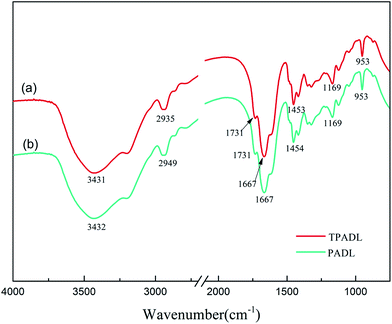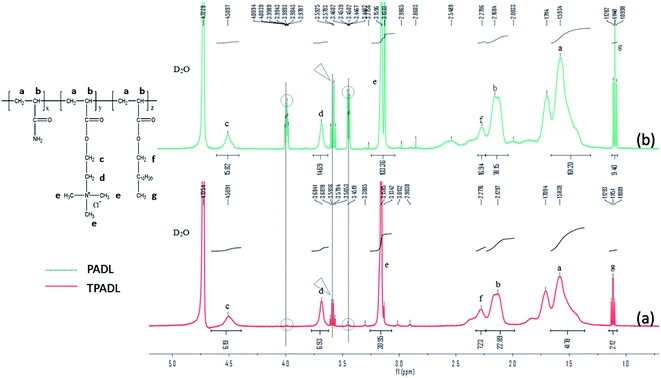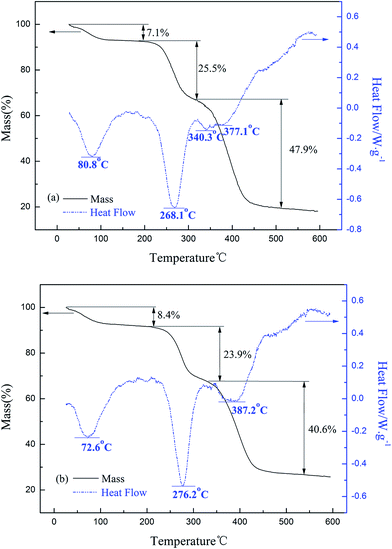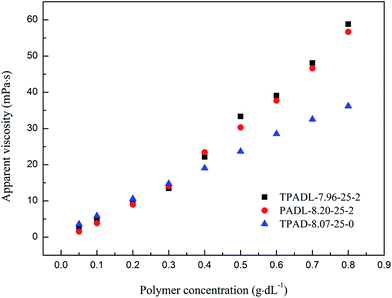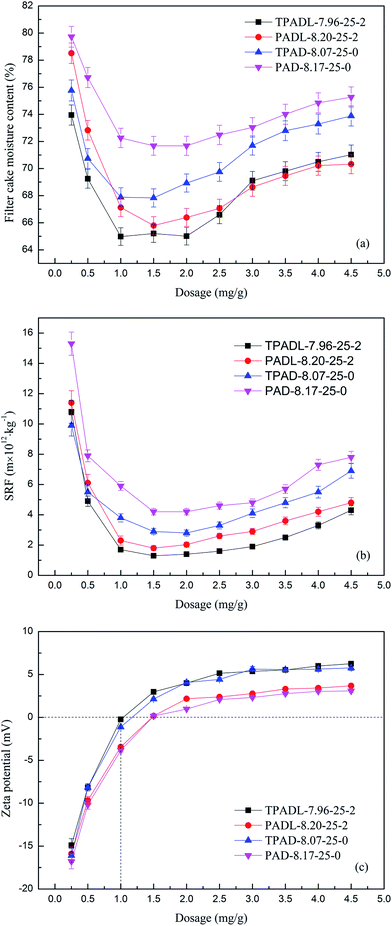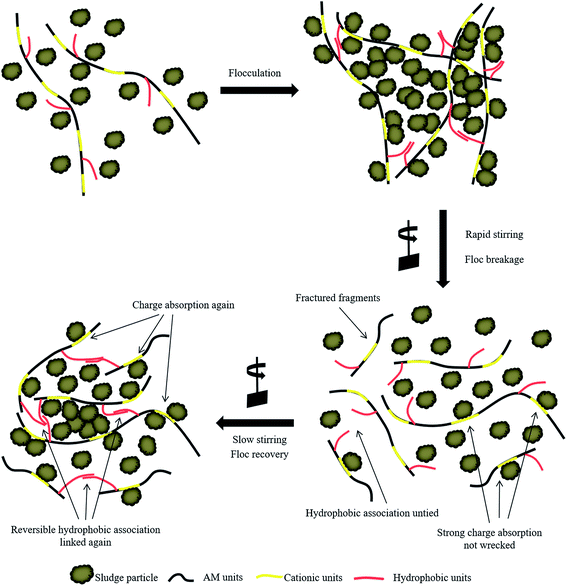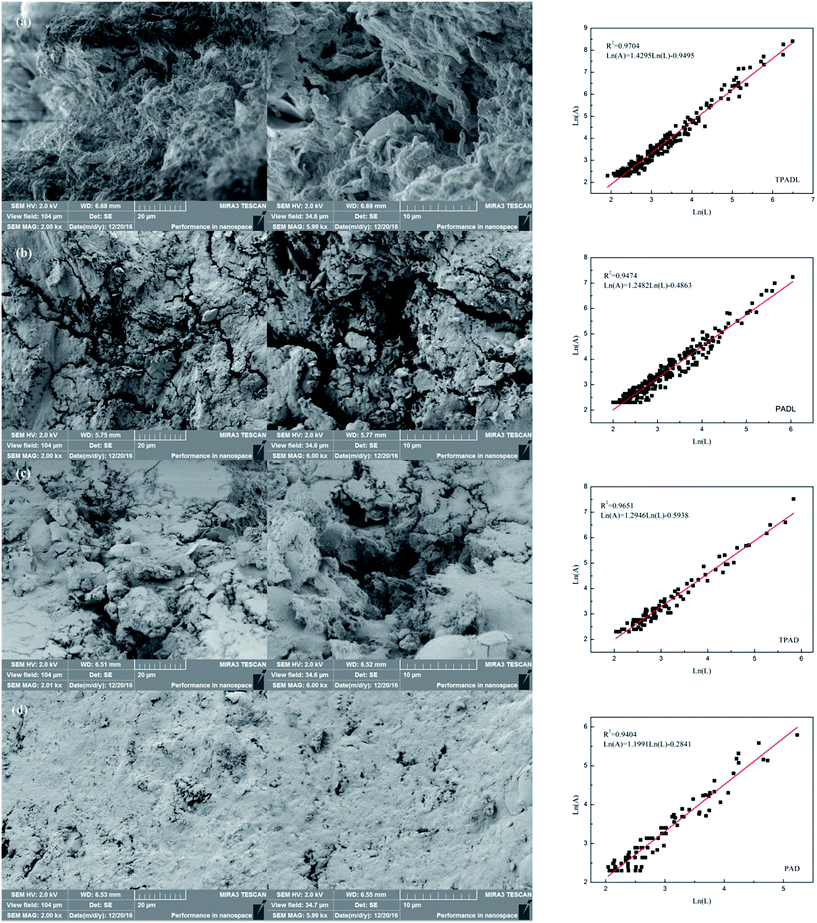 Open Access Article
Open Access ArticleWaste activated sludge (WAS) dewatering properties of an original hydrophobically modified polyacrylamide containing a cationic microblock structure†
Yuhao Zhou ab,
Huaili Zheng*ab,
Baoyu Gao
ab,
Huaili Zheng*ab,
Baoyu Gao c,
Yingpeng Guab,
Xiang Liab,
Bingzhi Liuab and
Andrea Mavarro Jiménezab
c,
Yingpeng Guab,
Xiang Liab,
Bingzhi Liuab and
Andrea Mavarro Jiménezab
aKey Laboratory of the Three Gorges Reservoir Region's Eco-Environment, State Ministry of Education, Chongqing University, Chongqing 400045, China. E-mail: zhl@cqu.edu.cn; Fax: +86 23 65120827; Tel: +86 23 65120827
bNational Centre for International Research of Low-Carbon and Green Buildings, Chongqing University, Chongqing 400045, China
cShandong Key Laboratory of Water Pollution Control and Resource Reuse, School of Environmental Science and Engineering, Shandong University, Jinan 250100, China
First published on 31st May 2017
Abstract
Chemical conditioning, as one of the core technologies used for the dewatering pretreatment of sludge, can efficiently improve the dewaterability of WAS and hence reduce the expense of the transportation and disposal of WAS. Cationic polyacrylamide has been widely utilized as a chemical conditioner owing to its high performance and economic advantages. However, high-performance and economical flocculants are still needed. In this study, a novel hydrophobically associating polyacrylamide, which was denoted as TPADL and contained a cationic microblock structure synthesized by a UV-initiated template copolymerization technique, was employed in a dewatering test on WAS. The chemical composition of TPADL was confirmed via hydrogen nuclear magnetic resonance (1H NMR) spectroscopy and Fourier transform infrared (FTIR) spectroscopy. Moreover, 1H NMR spectroscopy demonstrated a highly concentrated distribution of cations on the main chain. Furthermore, thermogravimetric analysis (TGA) was utilized to investigate the thermal stability of TPADL, and its apparent viscosity was also measured to evaluate its rheological characteristics. Dewatering tests found that the TPADL flocculant exerted a synergistic function owing to the cationic microblock structure and hydrophobic association and exhibited superior dewatering performance in comparison with normal random cationic polyacrylamide (CPAM). The filter cake moisture content (FCMC) and specific resistance to filtration (SRF) reached 64.98% and 1.3 × 1012 m kg−1, respectively, for TPADL at the optimal dosage of 1.5 mg g−1 dry solids of WAS (calculated value). The floc size distribution revealed that hydrophobic association remarkably increased the floc size owing to enhancements in bridging absorption ability, whereas the cationic microblock structure helped form a denser and more compact floc structure, and the higher charge neutralization ability enabled an increase in floc strength. In addition, the synergistic function significantly improved the regeneration ability of flocs. Scanning electron microscopy (SEM) analysis indicated that the stronger floc structure could act as a skeleton to form pores and a channel-like structure, which made filter cake a favorable draining medium for the release of water and thus contributed to an increase in dewaterability. This study provided an analysis for the development of high-performance and economic flocculants by a combination of the controllable concentrated distribution of cations and hydrophobic association.
1. Introduction
The volume of waste activated sludge (WAS) residues is dramatically increasing owing to the demand for improvements in pollutant removal made by current tightened regulations.1,2 The large quantities of WAS are a troublesome by-product of wastewater treatment plants (WWTPs), which need to be appropriately handled; otherwise, they could lead to serious environmental impacts.3 In China, the current production of dewatered WAS is greater than 3.0 × 107 tons (with a water content of 80%) and is expected to continue to increase owing to the stricter environmental regulations and growing amounts of wastewater.4,5 The management of WAS represents a considerable portion of the total operating costs of WWTPs and also causes a great economic burden.6,7 To reduce the environmental and economic impacts of WAS, dewatering is a crucial step for reducing moisture content and sludge volume by solid–water separation, which is an effective approach for reducing the expense of the transportation and disposal of WAS.8–10With the aim of reducing moisture content, various treatments can be applied before the final disposal of WAS.11 Mechanical dewatering is mostly performed in medium/large WWTPs.1 Nevertheless, without pretreatment, the heterogeneous and stable colloidal nature of WAS may considerably hinder the dewatering process and fail to meet the requirements of subsequent treatment processes.1,9
To enhance the dewaterability of sludge, various kinds of pretreatment process have been widely studied and developed, including thermal, chemical, magnetic, mechanical, acoustic, electric and hybrid pretreatment processes.12 Among these, chemical conditioning is one of the most efficient pretreatment processes for improving the dewatering performance of WAS. Cationic polyacrylamide, as one of the most widely applied chemical conditioners, can significantly improve the mechanical dewaterability of WAS by flocculating fine colloidal sludge particles to form giant flocs6,13 via the two extensively accepted mechanisms of bridging and surface charge neutralization.14
However, traditional cationic polyacrylamides synthesized by common methods usually have a random distribution of cationic units along the polymer chain. According to Guan et al. and Chen et al.,15,16 for such materials, owing to the dispersed arrangement of cationic units, charge neutralization cannot be fully utilized to neutralize the surface charge on particles. As shown in Fig. 1(a), many cationic units situated on loops and tails of the main chain are wasted. In contrast, the cationic microblock structure of the novel products synthesized by template copolymerization can provide stronger and less easily separated segments for absorption, as shown in Fig. 1(b), which lead to a stronger and more compact floc structure and hence better flocculation performance. Furthermore, the concentrated distribution of charge can provide a stretched linear configuration of the polymer chain in solution, which contributes to better bridging performance to form larger flocs, as was expected.17
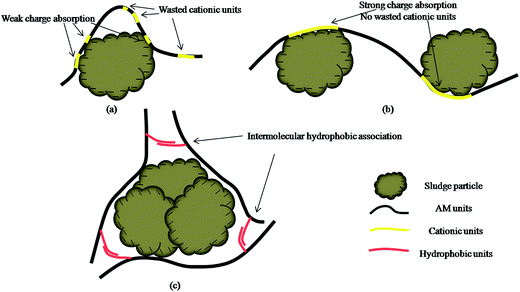 | ||
| Fig. 1 Schematic presentation of flocculation mechanism of polyacrylamide: (a) cationic randomly distributed copolymer, (b) cationic microblock copolymer and (c) hydrophobic association copolymer. | ||
Hydrophobic modification has been believed to be a promising way to enhance the performance of polymers.18,19 The incorporation of a small number of hydrophobic groups into a hydrophilic macromolecular chain imparts unique rheological characteristics.20 In aqueous solutions, hydrophobic groups on a polymer chain can aggregate together to form intra- and inter-molecular associations to minimize the exposure of the hydrophobic units to the solvent, as shown in Fig. 1(c). This kind of association, in particular, intermolecular association, can significantly increase the viscosity of the solution, as well as association reactions between hydrophobic groups along polymer chains and the hydrophobic constituents of WAS particles.21–23 Hence, the flocculation efficiency was improved.
The hydrophobically associating polyacrylamide with a cationic microblock structure denoted as TPADL was synthesized by UV-initiated template copolymerization of a cationic monomer (DAC), a hydrophobic monomer (LA) and acrylamide (AM). As can be imagined, both the cationic microblock structure and the hydrophobic groups were incorporated into the macromolecular polymer chain, and the stronger charge neutralization, bridging absorption, and hydrophobic association effects could together improve the flocculation performance during sludge dewatering treatment. Given that TPADL is supposed to provide better charge neutralization and bridging absorption performance, as well as interactions between the hydrophobic units of macromolecular flocculants and the hydrophobic components of fine colloidal particles in WAS, satisfactory efficiency in the solid-water separation of WAS would be achieved.
In order to decrease operating costs and guarantee the efficiency of dewatering to meet the needs of increasingly strict environmental legislation, it seemed essential and urgent to investigate the flocculation mechanism and floc properties in sludge dewatering. However, to the authors' knowledge, the employment of the novel high-performance TPADL in the dewatering of WAS has not yet been well studied. In this paper, the authors mainly focus on investigating the chemical properties of this novel TPADL, including determining its composition, structural characteristics and thermal stability by FTIR spectroscopy, 1H NMR spectroscopy and TGA analysis. The rheological characteristics of this TPADL in solution were also investigated. The dewaterability of WAS using this novel flocculant was evaluated in terms of the FCMC and SRF. The zeta potential and floc properties in terms of size distribution, floc breakage and recovery factor and fractal dimension were further measured for the thorough study of the flocculation mechanism.
2. Experimental section
2.1 Flocculants
2.2 Dewatering experiments
The flocculants utilized in the dewatering experiments were synthesized by a UV-initiated template copolymerization technique. The parameters of the flocculants employed in this study are listed in Table 1. All the flocculants were copolymerized under the optimal synthesis conditions with intrinsic viscosity as the objective for optimization. WAS samples were collected from Dadukou Drainage Co., Ltd. (Chongqing, China). The main process employed at this plant was a cyclic activated sludge system (CAST process) with a capacity of 50![[thin space (1/6-em)]](https://www.rsc.org/images/entities/char_2009.gif) 000 m3 d−1. The samples were stored under refrigeration at a temperature of 4 °C and were analyzed within 48 h. The main characteristics of the WAS are shown in Table 2.
000 m3 d−1. The samples were stored under refrigeration at a temperature of 4 °C and were analyzed within 48 h. The main characteristics of the WAS are shown in Table 2.
| Flocculant | Intrinsic viscosity (dL g−1) | Cationic degree (%) | Content of hydrophobic monomers (%) |
|---|---|---|---|
| TPADL-7.96-25-2 | 7.96 | 25 | 2 |
| PADL-8.20-25-2 | 8.20 | 25 | 2 |
| TPAD-8.07-25-0 | 8.07 | 25 | 0 |
| PAD-8.27-25-0 | 8.17 | 25 | 0 |
| Moisture content (%) | pH | Mass density (mL g−1) | ζ-Potential (mV) | Conductivity (mS cm−1) | d50 (μm) | VSS/TSS (mg L−1) |
|---|---|---|---|---|---|---|
| a VSS/TSS: volatile suspended solids/total suspended solids. | ||||||
| 98.6 ± 0.32 | 6.93 ± 0.15 | 0.936 | −24.1 ± 0.3 | 1.42 ± 0.2 | 62.17 | 0.66 ± 0.2 |
A programmable jar test apparatus (Wuhan Hengling Technology Ltd., China) was employed in the dewatering experiments. The efficiency of sludge dewatering was evaluated in terms of FCMC and SRF. For each type of flocculant, solutions with a concentration of 1 g L−1 were prepared with deionized water before use. A 500 mL sample of WAS was transferred into a 1 L plastic beaker, and a predetermined dosage of the flocculant was added to the system. Then, the sample was exposed to mechanical stirring conditions of 400 rpm for 30 s followed by 40 rpm for 8 min, which were required for the complete mixing of the colloidal particles and flocculant and floc growth, respectively.28 Then, the supernatant was extracted with a syringe at a depth of 1 cm below the sample surface for measurements of the zeta potential (ζ) using a Zetasizer Nano ZS90 (Malvern Instruments Ltd., Malvern, UK). The conditioned samples were filtered through a standard Buchner funnel with a 0.45 μm filter paper for 3 min under a constant pressure of 0.6 MPa provided by an air pump, and the volume of the filtrate was recorded every 10 s. Then, the filter cake was placed in a DHG-9070A drying oven (Gongyi Yuhua Instrument Co., Ltd., China) and dried at a low temperature of 60 °C for 72 h. The FCMC value was calculated from the following eqn (1):
 | (1) |
 | (2) |
2.3 Floc properties
The floc size distribution was measured with a BT-9300HT laser particle size analyzer (Beijing Judaohesheng Technology Co., Ltd., China). Floc breakage and recovery experiments were carried out as follows: the aforementioned flocculation process was followed by a subsequent breakage phase of 400 rpm for 30 s and a recovery phase of 40 rpm for 10 min. The floc size after each phase was determined as mentioned above. The floc breakage and recovery factors have previously been employed to represent the relative breakage and recovery processes of flocs.32,33 The breakage factor and recovery factor were calculated using the following eqn (3) and (4), respectively:
 | (3) |
 | (4) |
Field emission scanning electron microscopy (FESEM: Mira 3 LMU SEM system, TESCAN Company, Czech Republic) was employed to investigate the structural morphology of dry sludge cakes of conditioned samples. Image-Pro Plus software was also used to calculate the fractal dimension.34,35
3. Results and discussion
3.1 Characterization of TPADL
![[double bond, length as m-dash]](https://www.rsc.org/images/entities/char_e001.gif) O groups in the AM and LA monomers, and the peak that appears at 953 cm−1 originated from the –CO–O groups of LA monomers.27 The spectrum of PADL is shown in Fig. 2(b). When compared with that of TPADL, it is obvious that the characteristic peaks in Fig. 2(a) are all present in Fig. 2(b) and display only a slight shift in wavenumbers. This result indicates the formation of flocculants containing the monomers AM, DAC and LA and the similarity in composition between TPADL and PADL. It is worth noting that PAAS was successfully removed and did not participate in the copolymerization.
O groups in the AM and LA monomers, and the peak that appears at 953 cm−1 originated from the –CO–O groups of LA monomers.27 The spectrum of PADL is shown in Fig. 2(b). When compared with that of TPADL, it is obvious that the characteristic peaks in Fig. 2(a) are all present in Fig. 2(b) and display only a slight shift in wavenumbers. This result indicates the formation of flocculants containing the monomers AM, DAC and LA and the similarity in composition between TPADL and PADL. It is worth noting that PAAS was successfully removed and did not participate in the copolymerization.
The 1H NMR spectrum of PADL shown in Fig. 3(b) exhibits similar vibration signals to those of TPADL shown in Fig. 3(a), which indicates that the PADL flocculant has an identical composition to that of TPADL. However, several differences cannot be ignored, which are essential for analysis of the microblock structure. Notably, the signals detected at 3.90 ppm, 3.65 ppm and 3.52 ppm, which are marked by circles and a triangle, are significantly weakened owing to the template copolymerization technique. According to Guan et al. and Chen et al.,15,16 this phenomenon is attributed to the stereochemistry of the copolymers. The DAC monomer in the PADL polymer chain is in a disorganized sequence. This random distribution will give rise to several more resonance peaks owing to the steric interaction between different pendant groups. In contrast, the proton signals of the –O–CH2– (c), –CH2–N+ (d), and –N+(CH3)3 (e) groups in the cationic microblock structure, which are arranged along the PAAS chain via strong intermolecular ionic bonds when synthesized, can be uniform in general owing to the steric and electrostatic repulsion of the pendant groups, and only one resonance is observed for each single group in theory.37,38 Therefore, the three marked signals are obviously weakened owing to the identical sequence of cationic units in the cationic microblock structure. Undoubtedly, this centralized distribution of cationic units would efficiently enhance the charge neutralization performance and provide a more highly stretched linear configuration of the polymer chain in solution.
3.2 Dewatering performance
As illustrated in Fig. 6, the FCMC and SRF values of samples conditioned by a series of flocculants were determined to evaluate the dewaterability, and the zeta-potential was also determined to further investigate the flocculation mechanism. The purpose of this part of the study is to accurately evaluate the effect of the synergistic function of the cationic microblock structure and hydrophobic association on the dewaterability of sludge.Fig. 6(a) shows the respective results for the FCMC values of samples conditioned by four types of flocculant. The FCMC value was initially reduced by the addition of each type of flocculant. The lowest FCMC (about 65%), which was achieved with TPADL at a dosage of 1 mg g−1, was lower than the values of 73.1% and 67.8% reported by Liao et al.19 and Zheng et al.,27 respectively. However, the FCMC gradually increased again with further dosages in excess of the optimum value (1 mg g−1). The FCMC values of the conditioned samples were in the following order: TPADL < PADL < TPAD < PAD. The FCMC values of both PADL and TPAD were below 70%. According to Feng et al. and Zhang et al., the SRF value is accepted as an indicator for the evaluation of sludge filtration performance.43,44 In general, a lower SRF value indicates superior dewatering performance in mechanical dehydration.43 The SRF values of the conditioned samples are shown in Fig. 6(b). The results for the SRF values show a similar trend to those of the FCMC values. The SRF value first decreased in the dosage range of 0.25 mg g−1 to 1.5 mg g−1, and when the amount of flocculant added exceeded the optimal dosage (about 1.5 mg g−1) the SRF value began to rise. On the basis of the SRF results, TPADL exhibited better performance than the flocculants used for the other three samples over most of the dosage range, and the optimal SRF value of approximately 1.4 × 1013 m kg−1 was achieved with TPADL at a dosage of 1.5 mg g−1, which was lower than that reported by Wang et al.7
The superiority of the dewatering performance of TPADL revealed that the synergistic effect of hydrophobic association and the cationic microblock structure can facilitate the dewatering of sludge. The zeta potentials of the conditioned samples are shown in Fig. 6(c). From these curves, with an increase in the flocculant dosage the zeta potential rapidly increased from negative values (−24.1 mV) to the isoelectric point. The isoelectric point was reached at a dosage of about 1 mg g−1 for the cationic microblock copolymers and 1.5 mg g−1 for the ordinary cationic copolymers. This phenomenon reveals that the flocculants with a cationic microblock structure exhibited higher charge neutralization ability than that of flocculants with a random distribution of cations. The charge neutralization function could effectively reduce the repulsive effect of negative charge and compress the electrical double layer of colloidal sludge particles. The cationic microblock segment can be tightly adsorbed on the negatively charged surface of colloidal particles to reduce the hydrated shell by lowering the surface tension of water.16 As a result, a lower moisture content was achieved. Furthermore, this kind of concentrated distribution of cations can provide an expanded linear configuration of the polymer chain in the sludge solution. This elongated stretched shape and the physical network structure formed by intermolecular hydrophobic association can significantly increase the probability of collisions between the polymer chain and colloidal particles, so that the bridging effect is strengthened to help the aggregation of the particles to form giant and compact flocs.31 More details of the floc properties will be discussed in Section 3.3. Because the optimal dosage did not coincide with the exact isoelectric point, charge neutralization was not the only dominant mechanism but the bridging absorption effect also played an important role during the flocculation process.45
With further increases in dosage beyond the isoelectric point, the zeta potential continued to increase to positive values of 5 mV for the templated copolymers and approximately 2.5 mV for the normal cationic copolymers. In comparison with the phase before the isoelectric point, the rate of increase in the zeta potential significantly slowed down. This phenomenon can be explained by the electrostatic patching effect.46 In a colloidal system, when, or even after, the isoelectric point is reached, the floc surface may absorb several cationic microblock segments to form positively charged patches. Nevertheless, negatively charged surfaces are still present and exposed to the colloidal system. This kind of cationic patch can further absorb other negatively charged surfaces of flocs to aggregate into larger flocs.
During the entire dewatering test, TPADL displayed superior dewatering performance to those of the PADL and TPAD flocculants and significantly better performance than that of PAD. It can be confirmed that both hydrophobic association and a cationic microblock structure are suitable for the dewatering of sludge, and the reason for the superiority of TPADL is because of the synergistic effect of these factors.
3.3 Floc properties
The floc properties are closely related to the flocculation behavior in a sludge system. In order to obtain an in-depth understanding of the dewatering process caused by the synergistic effect of the cationic microblock structure and hydrophobic association, we further analyzed the floc properties of sludge in terms of the floc size distribution and breakage and recovery factors, as well as the surface morphology of the dried sludge.| Coagulant | After breakage (μm) | After recovery (μm) |
|---|---|---|
| TPADL-7.96-25-2 | 200.276 | 234.633 |
| PADL-8.20-25-2 | 193.661 | 236.889 |
| TPAD-8.07-25-0 | 173.113 | 185.225 |
| PAD-8.17-25-0 | 138.272 | 151.615 |
Table 4 shows the breakage and recovery factors for four flocculants at the optimal dosage. The breakage factor and recovery factor were calculated by eqn (3) and (4), respectively, which were mentioned before in Section 2.3. It can be seen that the introduction of the cationic microblock structure effectively increased both the breakage factor and the recovery factor. The reason for the increase in the breakage factor could be attributed to the enhancement of the bridging absorption effect. It is widely accepted that the polymer bridging effect can increase the strength of flocs.32 In our specific study, the concentrated distribution of cationic units can give rise to an expanded linear configuration of the polymer chain, which is beneficial for the occurrence of the bridging absorption effect in a flocculation system. Furthermore, this kind of cationic microblock segment could be tightly adsorbed on the negatively charged surface of sludge particles with fewer wasted cationic units, and the stronger electrostatic attraction force enables higher shearing resistance. This can explain how the breakage factor was increased by the cationic microblock structure. However, hydrophobic association exerted a comparatively negative effect on the breakage factor. Hydrophobic association is a kind of weak but reversible physical combination of hydrophobic groups on the polymer chain. When intermolecular hydrophobic association occurs, the physical network structure of the polymer chain can significantly reinforce the bridging absorption effect to form larger flocs. However, this kind of physical bond between hydrophobic groups is too weak to resist high shearing forces. Once a high shearing rate was applied to the flocculation system, the effect of hydrophobic association was easily overcome and giant flocs broke up into normal-sized flocs. Thus, hydrophobic association exerted a negative effect on the breakage factor. With the reintroduction of slow stirring after breakage, an apparent phenomenon of floc regrowth could be observed for all the conditioned samples except for that conditioned by PAD. When compared with the polymers with a random distribution of cations, the polymers with a cationic microblock structure displayed a comparatively high recovery ability. The recovery factors increased from 20.63% and 7.57% for PADL and PAD to 21.46% and 10.42% for TPADL and TPAD, respectively. This phenomenon is also proof that polymers with a concentrated distribution of cations exhibited stronger charge neutralization than those with a random distribution. Aguilar et al. and Jarvis et al. also mentioned the superior recovery capability of flocs that were formed mainly by the charge neutralization effect.48,49
| Coagulant | Breakage factor (%) | Recovery factor (%) |
|---|---|---|
| TPADL-7.96-25-2 | 55.57 | 21.46 |
| PADL-8.20-25-2 | 48.03 | 20.63 |
| TPAD-8.07-25-0 | 59.83 | 10.42 |
| PAD-8.17-25-0 | 43.96 | 7.57 |
According to the results for the recovery factor in Table 4, the introduction of hydrophobic association led to extraordinary improvements in the recovery ability of flocs. The recovery factors of TPAD and PAD were only 10.42% and 7.57%, but for TPADL and PADL the recovery factor significantly increased to 21.46% and 20.63%, respectively. The increase in the recovery factor was because of intermolecular hydrophobic association, which is a reversible association linked by physical bonding rather than chemical bonding. Although this weak physical bond will be easily destroyed under conditions of a high shearing force, once a slow stirring rate is applied to the flocculation system again after the breakage phase, this kind of physical link can rapidly reform to reaggregate the shattered flocs into large flocs. A possible mechanism of the regeneration of flocs by TPADL is displayed in Fig. 8.
In summary, the cationic microblock structure is beneficial for floc strength, and the synergistic effect of the cationic microblock structure and hydrophobic association can significantly improve the regeneration capability of flocs; hydrophobic association plays the crucial role in the regeneration process of flocs.
4. Conclusions
A novel hydrophobically modified polyacrylamide containing a cationic microblock structure, which was denoted as TPADL, was utilized as a flocculant in the conditioning of WAS to improve the dewaterability. The chemical structures were characterized using advanced instrumentation, and the dewatering performance, as well as the flocculation mechanism, was subjected to comparative study. The major conclusions of the present study were as follows:(a) The results of FTIR and 1H NMR spectroscopy indicate the successful preparation of TPADL from monomers of AM, DAC and LA. Moreover, the obvious weakening of the interference signal peak in the 1H NMR spectrum confirmed the presence of the specific identical cationic sequence in the cationic microblock structure, which is favorable for higher charge neutralization ability. TGA analysis revealed acceptable thermal stability, and the two apparent stages of heat absorption peaks further demonstrated the existence of the cationic microblock structure. Measurements of the apparent viscosity indicated that the introduction of hydrophobic groups can help to form a reversible physically cross-linked network structure, which is beneficial for bridging absorption ability and the recovery ability of flocs.
(b) Dewatering experiments confirmed the superiority of TPADL. The FCMC and SRF values were 64.98% and 1.3 × 1012 m kg−1, respectively, for TPADL at the optimal dosage of 1.5 mg g−1 DS, which were lower than the values for the samples conditioned by other flocculants employed for comparison. The synergistic function of the cationic microblock structure and hydrophobic association effectively improved the dewaterability of WAS. The results for the zeta potential also revealed that the concentrated distribution of cations enabled stronger charge neutralization than the random distribution of cations in the dewatering test.
(c) According to the results for the floc size distribution, the hydrophobic association effect can markedly increase the floc size, and the cationic microblock structure can help to form a more compact floc structure. Moreover, the breakage and recovery factors significantly increased because of this synergistic function. The stronger floc structure can function as a skeleton structure to form pores and a channel-like structure in the filter cake, which make it a favorable draining medium for the release of water.
These results may be useful in the development of new high-performance flocculants and the in-depth study of the dewatering behavior of WAS.
Conflict of interest
The authors declare no competing financial interest.Abbreviations
| WAS | Waste activated sludge |
| WWTP | Wastewater treatment plant |
| UV | Ultraviolet |
| CPAM | Cationic polyacrylamide |
| DAC | 2-(Acryloyloxy)-N-benzyl-N,N-dimethylethanaminium chloride |
| LA | Lauryl acrylate |
| AM | Acrylamide |
| PAAS | Sodium polyacrylate |
| V-044 | 2,2′-Azobis[2-(2-imidazolin-2-yl)propane]dihydrochloride |
| 1H NMR | 1H nuclear magnetic resonance |
| FTIR | Fourier transform infrared spectroscopy |
| TGA | Thermogravimetric analysis |
| SEM | Scanning electron microscopy |
| FCMC | Filter cake moisture content |
| SRF | Specific resistance to filtration |
| VSS/TSS | Volatile suspended solids/total suspended solids |
| TPADL | Templated poly(AM-DAC-LA) |
| PADL | Poly(AM-DAC-LA) |
| TPAD | Templated poly(AM-DAC) |
| PAD | Poly(AM-DAC) |
| d50 | Median particle size |
| CAC | Critical association concentration |
Acknowledgements
This research was supported by the National Natural Science Foundation of China (Project No. 21677020 and 21477010).References
- D. Panepinto, S. Fiore, G. Genon and M. Acri, J. Cleaner Prod., 2016, 137, 1323–1329 CrossRef.
- E. Farno, J. C. Baudez, R. Parthasarathy and N. Eshtiaghi, Chem. Eng. J., 2016, 304, 362–368 CrossRef CAS.
- P. Li, H. Li, J. Li, X. Guo, J. Liu and B. Xiao, Bioresour. Technol., 2016, 221, 31–36 CrossRef CAS PubMed.
- Q. H. Zhang, W. N. Yang, H. H. Ngo, W. S. Guo, P. K. Jin, M. Dzakpasu, S. J. Yang, Q. Wang, X. C. Wang and D. Ao, Environ. Int., 2016, 92–93, 11–22 CrossRef CAS PubMed.
- X. Guo, J. Yang, Y. Liang, J. Liu and B. Xiao, Bioprocess Biosyst. Eng., 2014, 37, 553–560 CrossRef CAS PubMed.
- B. Cao, W. Zhang, Q. Wang, Y. Huang, C. Meng and D. Wang, Water Res., 2016, 105, 615–624 CrossRef CAS PubMed.
- L. Wang, L. Wang, W. Li, D. He, H. Jiang, X. Ye, H. Yuan, N. Zhu and H. Yu, Chem. Eng. Sci., 2014, 116, 228–234 CrossRef CAS.
- W. Zhang, P. Yang, X. Yang, Z. Chen and D. Wang, Bioresour. Technol., 2015, 181, 247–253 CrossRef CAS PubMed.
- W. Zhang, B. Cao, D. Wang, T. Ma, H. Xia and D. Yu, Water Res., 2016, 88, 728–739 CrossRef CAS PubMed.
- Y. Shi, J. Yang, W. Yu, S. Zhang, S. Liang, J. Song, Q. Xu, N. Ye, S. He, C. Yang and J. Hu, Chem. Eng. J., 2015, 270, 572–581 CrossRef CAS.
- M. Garrido-Baserba, M. Molinos-Senante, J. M. Abelleira-Pereira, L. A. Fdez-Güelfo, M. Poch and F. Hernández-Sancho, J. Cleaner Prod., 2015, 107, 410–419 CrossRef CAS.
- Y. Li, X. Yuan, Z. Wu, H. Wang, Z. Xiao, Y. Wu, X. Chen and G. Zeng, Chem. Eng. J., 2016, 303, 636–645 CrossRef CAS.
- H. Luo, X. Ning, X. Liang, Y. Feng and J. Liu, Bioresour. Technol., 2013, 139, 330–336 CrossRef CAS PubMed.
- S. Agarwal, M. Abu-Orf and J. T. Novak, Water Res., 2005, 39, 1301–1310 CrossRef CAS PubMed.
- Q. Guan, H. Zheng, J. Zhai, C. Zhao, X. Zheng, X. Tang, W. Chen and Y. Sun, Ind. Eng. Chem. Res., 2014, 53, 5624–5635 CrossRef CAS.
- W. Chen, H. Zheng, Q. Guan, H. Teng, C. Zhao and C. Zhao, Ind. Eng. Chem. Res., 2016, 55, 2892–2902 CrossRef CAS.
- B. Bolto and J. Gregory, Water Res., 2007, 41, 2301–2324 CrossRef CAS PubMed.
- K. E. Lee, N. Morad, B. T. Poh and T. T. Teng, Desalination, 2011, 270, 206–213 CrossRef CAS.
- Y. Liao, H. Zheng, L. Qian, Y. Sun, L. Dai and W. Xue, Ind. Eng. Chem. Res., 2014, 53, 11193–11203 CrossRef CAS.
- Z. L. Yang, B. Y. Gao, C. X. Li, Q. Y. Yue and B. Liu, Chem. Eng. J., 2010, 161, 27–33 CrossRef CAS.
- D. A. Z. Wever, F. Picchioni and A. A. Broekhuis, Prog. Polym. Sci., 2011, 36, 1558–1628 CrossRef CAS.
- K. C. Taylor and H. A. Nasr-El-Din, J. Pet. Sci. Eng., 1998, 19, 265–280 CrossRef CAS.
- Y. J. Feng, L. Billon, B. Grassl, G. Bastiat, O. Borisov and J. Francois, Polymer, 2005, 46, 9283–9295 CrossRef CAS.
- H. Zheng, Y. Sun, C. Zhu, J. Guo, C. Zhao, Y. Liao and Q. Guan, Chem. Eng. J., 2013, 234, 318–326 CrossRef CAS.
- X. Li, H. Zheng, B. Gao, Y. Sun, B. Liu and C. Zhao, Chemosphere, 2017, 167, 71–81 CrossRef CAS PubMed.
- Z. Zhang, H. Zheng, F. Huang, X. Li, S. He and C. Zhao, Ind. Eng. Chem. Res., 2016, 55, 9819–9828 CrossRef CAS.
- H. Zheng, Y. Sun, J. Guo, F. Li, W. Fan, Y. Liao and Q. Guan, Ind. Eng. Chem. Res., 2014, 53, 2572–2582 CrossRef CAS.
- K. V. Gorin, Y. E. Sergeeva, V. V. Butylin, A. V. Komova, V. M. Pojidaev, G. U. Badranova, A. A. Shapovalova, I. A. Konova and P. M. Gotovtsev, Bioresour. Technol., 2015, 193, 178–184 CrossRef CAS PubMed.
- J. Wang, S. Yuan, Y. Wang and H. Yu, Water Res., 2013, 47, 2643–2648 CrossRef CAS PubMed.
- Y. Qi, K. B. Thapa and A. F. A. Hoadley, Chem. Eng. J., 2011, 171, 373–384 CrossRef CAS.
- M. Niu, W. Zhang, D. Wang, Y. Chen and R. Chen, Bioresour. Technol., 2013, 144, 337–343 CrossRef CAS PubMed.
- P. Jarvis, B. Jefferson, J. Gregory and S. A. Parsons, Water Res., 2005, 39, 3121–3137 CrossRef CAS PubMed.
- P. Jarvis, B. Jefferson and S. A. Parsons, Environ. Sci. Technol., 2005, 39, 2307–2314 CrossRef CAS PubMed.
- G. Zhu, H. Zheng, Z. Zhang, T. Tshukudu, P. Zhang and X. Xiang, Chem. Eng. J., 2011, 178, 50–59 CrossRef CAS.
- H. Zheng, G. Zhu, S. Jiang, T. Tshukudu, X. Xiang, P. Zhang and Q. He, Desalination, 2011, 269, 148–156 CrossRef CAS.
- G. O. Yahaya, A. A. Ahdab, S. A. Ali, B. F. Abu-Sharkh and E. Z. Hamad, Polymer, 2001, 42, 3363–3372 CrossRef CAS.
- H. S. Samanta and S. K. Ray, Carbohydr. Polym., 2014, 99, 666–678 CrossRef CAS PubMed.
- Z. Abdollahi, M. Frounchi and S. Dadbin, J. Ind. Eng. Chem., 2011, 17, 580–586 CrossRef CAS.
- Y. Liu, C. Lin and Y. Wu, J. Hazard. Mater., 2007, 146, 255–261 CrossRef CAS PubMed.
- A. Gök, M. Omastová and J. Prokeš, Eur. Polym. J., 2007, 43, 2471–2480 CrossRef.
- J. Ma, P. Cui, L. Zhao and R. Huang, Eur. Polym. J., 2002, 38, 1627–1633 CrossRef CAS.
- X. Wan, Y. Li, X. Wang, S. Chen and X. Gu, Eur. Polym. J., 2007, 43, 3655–3661 CrossRef CAS.
- X. Feng, J. Deng, H. Lei, T. Bai, Q. Fan and Z. Li, Bioresour. Technol., 2009, 100, 1074–1081 CrossRef CAS PubMed.
- Z. Zhang, S. Xia and J. Zhang, Water Res., 2010, 44, 3087–3092 CrossRef CAS PubMed.
- K. A. S. Meraz, S. M. P. Vargas, J. T. L. Maldonado, J. M. C. Bravo, M. T. O. Guzman and E. A. L. Maldonado, Chem. Eng. J., 2016, 284, 536–542 CrossRef CAS.
- W. Chen, H. Zheng, H. Teng, Y. Wang, Y. Zhang, C. Zhao and Y. Liao, PLoS One, 2015, 10, e137116 Search PubMed.
- Y. X. Zhao, B. Y. Gao, Q. B. Qi, Y. Wang, S. Phuntsho, J. H. Kim, Q. Y. Yue, Q. Li and H. K. Shon, J. Hazard. Mater., 2013, 258–259, 84–92 CrossRef CAS PubMed.
- M. I. Aguilar, J. Sáez, M. Lloréns, A. Soler and J. F. Ortuño, Water Res., 2003, 37, 2233–2241 CrossRef CAS PubMed.
- P. Jarvis, B. Jefferson and S. A. Parsons, Water Res., 2006, 40, 2727–2737 CrossRef CAS PubMed.
Footnote |
| † Electronic supplementary information (ESI) available. See DOI: 10.1039/c7ra02939j |
| This journal is © The Royal Society of Chemistry 2017 |

